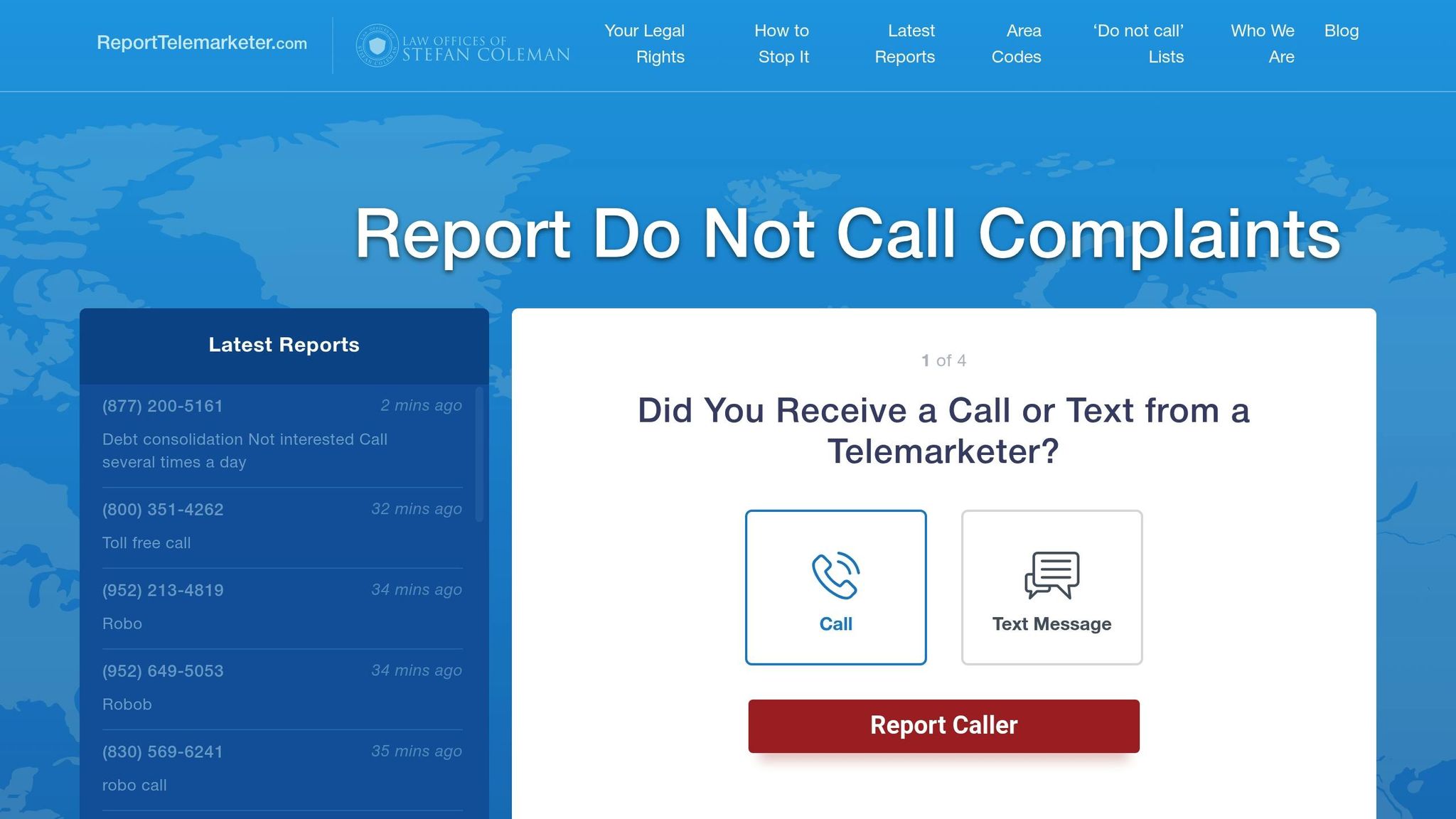
Filing a TCPA complaint can help stop spam calls, texts, and faxes while holding violators accountable. To file an effective report, you need detailed evidence. Here’s what to include:
- Call/Text Details: Date, time, caller ID, and content of the communication.
- Caller Information: Company name, representative’s name, and callback number.
- Your Response: Any opt-out requests or actions you took.
- Do Not Call Registry Status: Confirm if your number is on the registry.
- Consent Records: Proof of prior consent or opt-out attempts.
Why it matters: Missing details can weaken your report. Strong documentation ensures agencies like the FCC and FTC can act against violators. Keep records like screenshots, call logs, and emails in one place for easy access.
Need help? Services like ReportTelemarketer.com can assist with investigations, filing complaints, and even pursuing compensation of $500–$1,500 per violation.
Complete guide to sue telemarketers: $1500 per violation
Why TCPA Reports Fail
Filing a solid TCPA complaint requires detailed and accurate documentation. Unfortunately, many reports fall short due to avoidable mistakes and missing information.
Common Mistakes in Reporting
Some of the most frequent errors that lead to rejected TCPA reports include:
- Leaving out the caller’s name or company details
- Omitting or providing incomplete caller ID information
- Failing to verify whether your number is listed on the Do Not Call Registry
Why Missing Details Matter
When reports are incomplete, enforcement efforts suffer. Regulatory agencies rely on thorough documentation to identify violators, spot patterns, and take action. Missing details can delay investigations and weaken cases. Here’s how each key element strengthens your complaint:
| Key Information | How It Helps |
|---|---|
| Call Details | Tracks violations accurately |
| Caller Information | Identifies and contacts violators |
| Documentation | Serves as evidence for enforcement |
| Registry Status | Confirms violations of Do Not Call rules |
The Power of Complete Reports
Filing a well-documented complaint can make all the difference. Agencies like the FCC and FTC prioritize reports that include comprehensive evidence. To improve your chances:
- Keep records of all unwanted communications, including texts, voicemails, and call logs. Note dates, times, durations, and caller details.
- Submit all this evidence when filing your complaint.
A detailed report not only helps authorities connect related complaints but also strengthens enforcement efforts against repeat offenders. This increases the likelihood of holding violators accountable.
Required Information for TCPA Reports
Filing a TCPA report requires thorough documentation. Including all necessary details can make the difference between a report that gets attention and one that is dismissed.
Basic Report Information
The core of any TCPA report is a clear record of the call or text details. Be sure to include:
| Detail | What to Include |
|---|---|
| Date and Time | The exact date and time of each call or text |
| Contact Method | Specify if it was a call, text, or robocall |
| Caller Details | Include the company name, representative’s name, and callback number |
| Call Content | Outline the purpose of the contact and any products or services mentioned |
| Your Response | Note any opt-out requests you made during the interaction |
If the call was from a live agent or a prerecorded message, make sure to note that. For texts, save screenshots showing the message content and sender’s number.
Keep all evidence – screenshots, recordings, text copies, and notes – in a dedicated folder for easy access.
Next, confirm your phone number’s status to strengthen your TCPA claim.
Phone Number Status
Your phone number’s status is crucial in proving a TCPA violation. Make sure to document the following:
- Do Not Call Registry Status
Check if your number is registered on the National Do Not Call Registry and note the registration date. This shows you’ve taken steps to avoid unwanted calls. - Consent History
Record any past interactions with the company, including:- Whether you’ve done business with them before
- Any consent you previously gave or revoked
- Dates of opt-out requests
- Efforts you’ve made to stop further communication
Keep a detailed timeline showing when and how you requested to stop receiving calls or texts. A clear record of non-consent can greatly support your case.
Having all of this information ready ensures regulatory agencies have what they need to investigate violations and address non-compliant telemarketers.
sbb-itb-a8d93e1
Recording Consent and Opt-Outs
Keeping detailed records of consent and opt-out interactions is crucial for supporting your claims in a TCPA report. Proper documentation of your consent status and opt-out requests can strengthen your case.
Documenting Non-Consent
Having clear evidence of your opt-out requests and consent status is key to identifying TCPA violations. Here’s what to record:
| Action Type | What to Document | Required Details |
|---|---|---|
| Initial Opt-Out | Text message replies | Screenshot showing "STOP", "QUIT", or "CANCEL" response |
| Alternative Methods | Phone calls or emails | Date, time, recipient contact info, and confirmation receipts |
| Follow-up Messages | Company responses | Screenshots of confirmation texts or emails |
| Unsuccessful Attempts | Failed opt-outs | Records of error messages or bounced emails |
Keep copies of emails or voicemails revoking consent to help establish your case. These records can serve as a strong foundation for the evidence you’ll need later.
Call and Text Records
When you revoke consent, it applies to all robocalls and robotexts, no matter how you opted out. Be sure to track these details:
- Message Documentation
Log every unwanted call or text, noting the date, time, sender, and message content. Remember, companies are required to honor opt-out requests within 10 business days. - Confirmation Messages
Save any confirmation texts you receive after opting out. If two-way texting isn’t available, document any alternative opt-out methods provided by the company, like website links or phone numbers. Companies must clearly disclose limitations and offer reasonable alternatives.
You’re not limited to a single opt-out method. Record every attempt you make to revoke consent, no matter the channel. Organize these records carefully to simplify the TCPA reporting process.
Reporting Methods and Services
You can report TCPA violations through government agencies or by using specialized services.
Government Reporting Options
The Federal Communications Commission (FCC) and Federal Trade Commission (FTC) provide free platforms for reporting TCPA violations. Here’s a quick look at what each agency handles:
| Agency | Focus | How to Report |
|---|---|---|
| FCC | Complaints about unwanted texts and autodialed messages | fcc.gov/complaints |
| FTC | Issues with Do Not Call violations and phone scams | donotcall.gov |
| TIGTA | IRS-related scam calls | tigta.gov or 1-800-366-4484 |
You can also register your phone number with the National Do Not Call Registry by calling 1-888-382-1222 or visiting donotcall.gov. This strengthens your case against illegal calls. For a more tailored approach, consider using third-party services like ReportTelemarketer.com.
Third-Party Services: ReportTelemarketer.com

Third-party services can simplify the process of addressing TCPA violations. ReportTelemarketer.com offers a range of tools to handle these issues efficiently:
- Investigation Tools: They use advanced methods to track down telemarketers and confirm whether they had permission to contact you.
- Legal Steps: If a violation is confirmed, they can send cease-and-desist letters or file formal complaints on your behalf, all at no cost.
- Compensation Assistance: You may qualify to recover $500 for each illegal call or text.
The service is backed by consumer protection attorney Stefan Coleman, who ensures your privacy is safeguarded throughout the process. This is particularly helpful for persistent offenders or more complicated cases that need legal expertise.
How to Submit Strong TCPA Reports
Collecting Evidence
To build a strong case, gather evidence for each unwanted call or text. Record details like the date, time, and caller ID, and save any screenshots, recordings, or call logs. For live calls, make sure to note the caller’s name, company, contact information, and the purpose of the call.
Writing Your Report
Your report should include all key details. Here’s a breakdown of what to include:
| Required Information | Details to Include |
|---|---|
| Contact History | Dates, times, and how often calls or texts occurred |
| Communication Type | Specify if it was a live call, robocall, or text message |
| Consent Status | Clarify if you gave or revoked permission |
| Do Not Call Status | Confirm if you’re listed on the National Do Not Call Registry |
| Previous Opt-Outs | Provide records of any prior requests to stop contact |
For robocalls, include any identifying details like company names, product offers, callback numbers, or website links. Once your report is ready, take additional steps to strengthen your case.
Next Steps After Reporting
After submitting your report, here’s what to do next:
- Keep Recording Violations
Continue documenting any new unwanted calls or texts. - Monitor Communication
Pay attention to whether the calls or texts persist, and note any changes in frequency or patterns. - Seek Legal Advice
If the unwanted communication doesn’t stop, reach out to a TCPA attorney. They can help you gather more evidence, explore legal options, and determine if filing a lawsuit is the right move.
For extra help, ReportTelemarketer.com offers services to investigate violations and handle legal actions. Their team can assist with organizing your documentation and filing formal complaints, ensuring your case is presented effectively.
Conclusion
Complete TCPA reports play a key role in shielding you from unwanted telemarketing. With TCPA litigation surging by 1,273% since 2010, having detailed documentation is more important than ever. Each violation could lead to penalties ranging from $500 to $1,500 per incident.
Accurate and thorough documentation is the backbone of effective TCPA reporting. Fortunately, modern tools and specialized services make this process easier. The structured steps outlined earlier in this guide can help ensure your complaint is taken seriously by regulatory authorities.
If you need additional support, consumer protection services like ReportTelemarketer.com provide free assistance with documenting violations and filing formal complaints. Using these resources not only helps protect your rights but also strengthens enforcement efforts against illegal telemarketing practices.